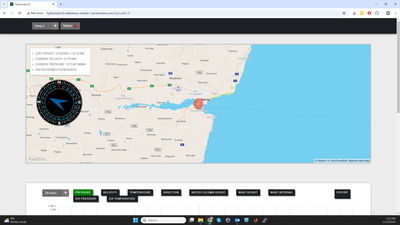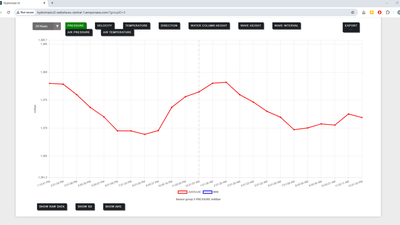Hydromast - water flow and wave measurement device
Hydromast is an in-situ measurement device for measuring water flow velocity and direction, as well as water level height and wave parameters. It is a low-cost and easy to use device, ideal for long-time and/or distributed monitoring of costal processes, near-bed currents, harbour flows, river flows etc.
The Hydromast can be deployed either as a stand-alone device with internal logging and battery pack or as an online device using the serial connection with reconfigurable embedded software. Hydromast can be equipped with communication capabilities to allow near real-time data transfer and monitoring.
Measurement specifications
Measurement capability
- Flow Velocity (range determined by the length of the mast):
HM100: 0.6 - 1.7 m/s (± 0.1 m/s)
HM300: 0.15 - 1.0 m/s (± 0.1 m/s)
HM500: 0.07 – 0.5 m/s (± 0.1 m/s)
- Directionality: 0 - 360° ± 12°
- Water level: 0 –20 or 200 m ± 0.25 % FS
- Temperature: -20°C to +50°C ± 1°C
- Temporal resolution: 2 Hz
Data output options:
- Processed data (sampling rate selectable)
- Processed averages – desired time interval and averaging time
- Raw data (50 Hz) (RS485 protocol)
Output parameters:
- Flow velocity
- Flow direction
- Water level
- Water temperature
- Wave amplitude
- Wave period
- Timestamp
- Optionally configurable raw data output variables
Collaborations
TalTech has been working with pilots in Crete (Heraklion port), Bulgaria (Varna port), Italy (Mussel farm on the Adriatic coast) and Estonia (Coastal sediment studies) by providing them Hydromasts, but has also in collaboration with them been upgrading and improving the current sensors.
Find out more about the Hydromast on ILIAD Youtube:
https://youtu.be/W_53WQjtdpg?si=ZDE8eixJu9-peArU
Example Hydromast datasets available on EMODnet
Background
Hydromast was initially developed for continuous cost-effective measurements of the near-field, large-scale hydrodynamic situation, for environmental monitoring in cabled ocean observatories, marine renewable energy and port/harbor security in a H2020 project Lakhsmi and is developed further in H2020 project ILIAD.
The Hydromast is inspired by the biological lateral line, which are the mechanoreceptive flow sensing organs of fish. Specifically, it is an upscaled version of the neuromast, and consists of a vibrating stem elastically fixed to a pressure sensitive body.
Technical Description
The Hydromast consists of following main components:
- Flow sensitive mast: the sensing unit of the Hydromast, that is covered with copper tape against biofouling. The height, diameter and buoyancy determine the sensitivity for flow measurements of the Hydromast.
- Silicone membrane: The silicone membrane is used to fix the mast of the Hydromast housing and acts as a spring element for the vibrating mast. The membrane has a cast in rigid part that acts as a coupler between the silicone and holds the mounting hole for the mast and has also a 5x5mm cylindrical neodymium magnet attached.
- Magnet: a 5x5mm cylindrical neodymium magnet is used for detection the tilt angle of the mast through the casing
- Hall sensor: An 3D Hall sensor (TLV493D, by Infineon) is used to detect the rotation of the magnet through the casing of the mast.
- Pressure sensor: An absolute pressure sensor with stainless steel hull is used in the Hydromast to detect water level fluctuations.
- Microcontroller and sensor’s data acquisition electronics: ATMEGA SAM4 based microcontroller for reading the pressure and Hall sensor raw data and processing to velocity magnitude, direction, water level height and wave parameters.
- Connection port: A waterproof cable gland for serial data connection using RS-485 protocol. The Hydromast can be deployed either as a stand-alone device with internal logging and battery pack or as an online device using the serial connection with reconfigurable embedded software.
Mechanical Specifications
The device includes a CNCd POM plastic casing that houses the electronics with double o-ring seal to allow installation depths up to 75m. SeaCon 4-pin wet connectors are used to allow easy installation and connection or replacement of the Hydromast under water. In addition the Hydromast can be equipped with IMU module to allow to evaluate the installation bearing when installed in open water conditions. The flow sensitive mast of the device is made of Polycarbonate that is covered with copper to avoid biofouling growth.
Electrical specifications
The Hydromasts can be powered with 5 to 12V with power usage of <150mW (5V max 30 mA). 4-pin Seacon connetors are used to allow the installation to take place under water. Additionally the Hydromast are connected to a sensor hub that allow simultaneous connection of several devices, that acts as a hydromast interrogator and works as a communication module. Depending on the communication protocol used, various power consumptions are possible:
- Sensor only (Hydromast): <150 mW (5V max 30 mA), up to 500mW with voltage converter
- Ethernet: <3W
- GSM: always online using 4G: average 6.5W (13V 0.5A)
- WiFi: <5W
- LoRa: with sensor hub 2W, direct connection to sensor <500mW
- RS-232: with sensor hub 2W, direct connection to sensor <300mW
Connectivity
Possible communication protocols on the hardware side for the Hydromasts are as following:
- Direct connection to Hydromast sensor – RS-485 (115200 baud rate)
- Connection via a sensor hub (based on a minicomputer, such as Beaglebone Black/Green or Raspberry Pi 3):
- Ethernet
- GSM (2G, 3G, 4G)
- WiFi
- LoRa (LoRaWAN)
- Serial: RS-485 (possible to add RS-232)
Framework architecture
Within ILIAD project, TalTech has developed a custom framework for communication and data storage on the sensor, on the sensor hub in case of several devices and also on cloud.
The price varies based on the number of devices, installation location, communication requirements, and support needed. Please request a quote for a customized offer.


